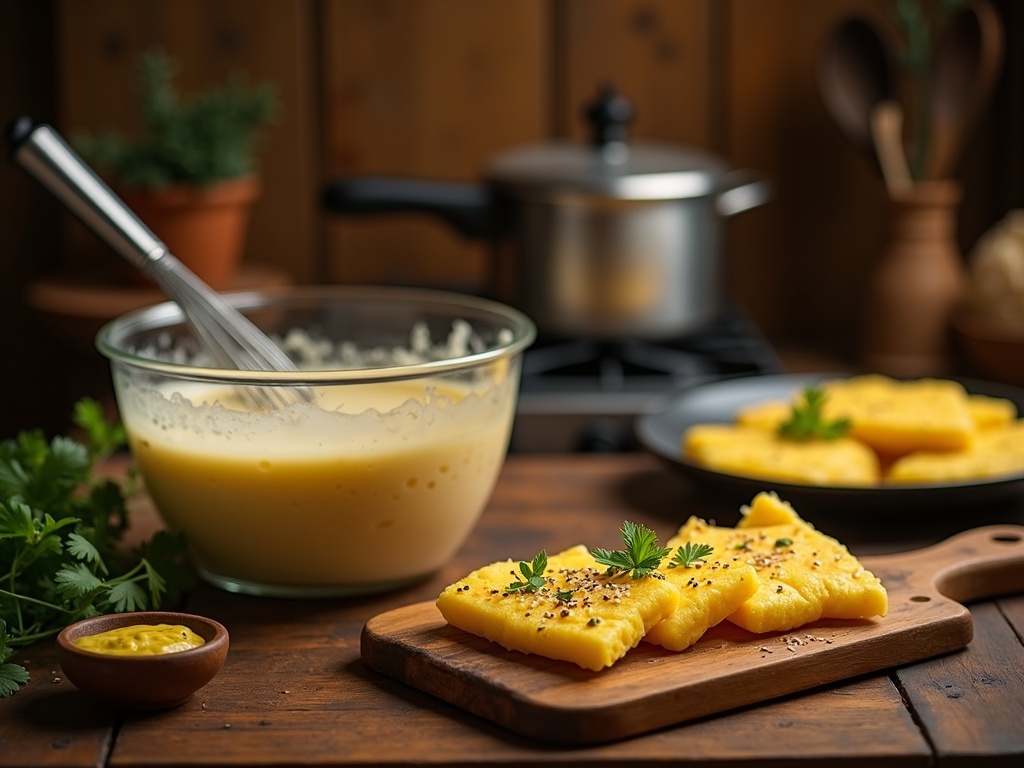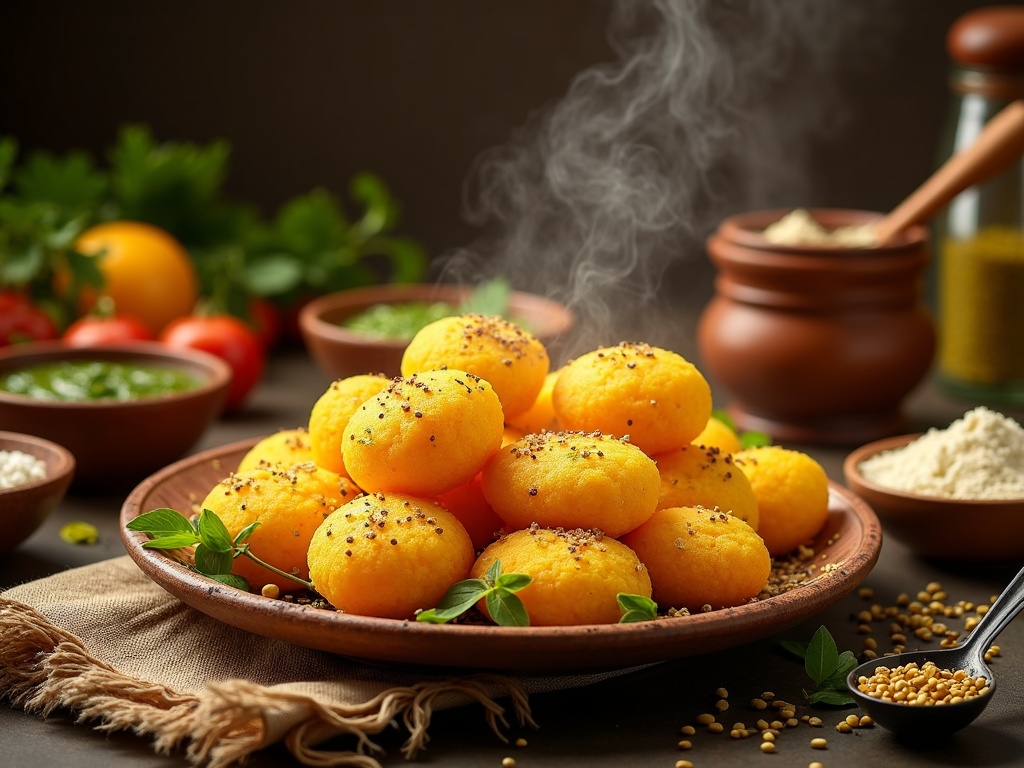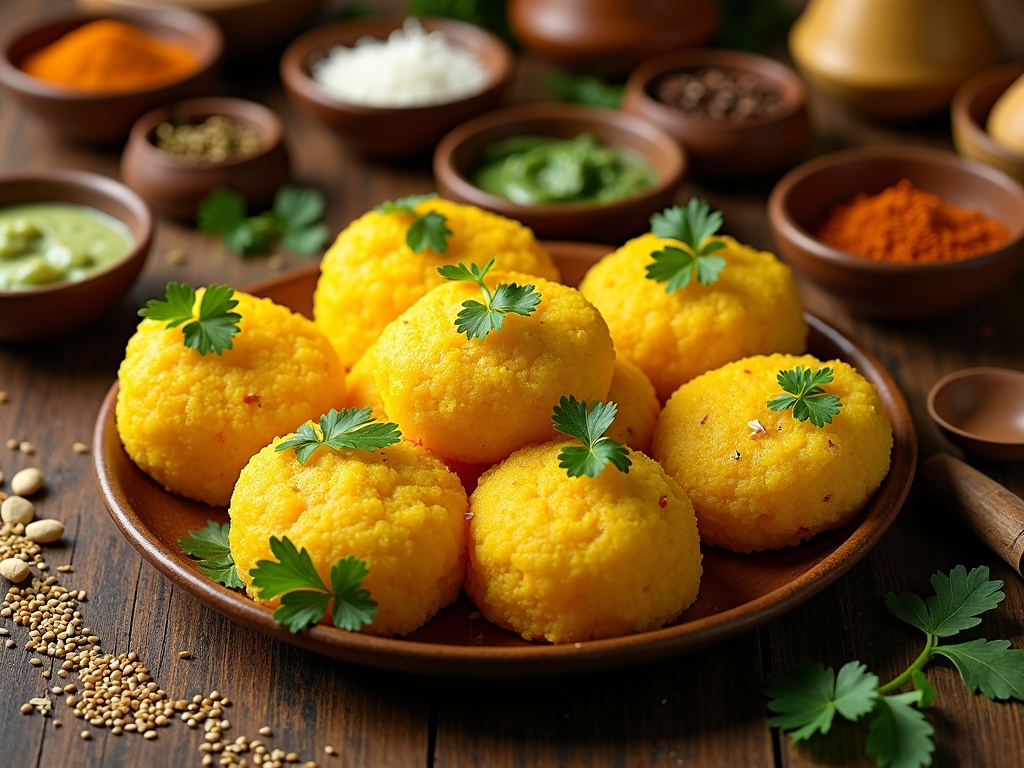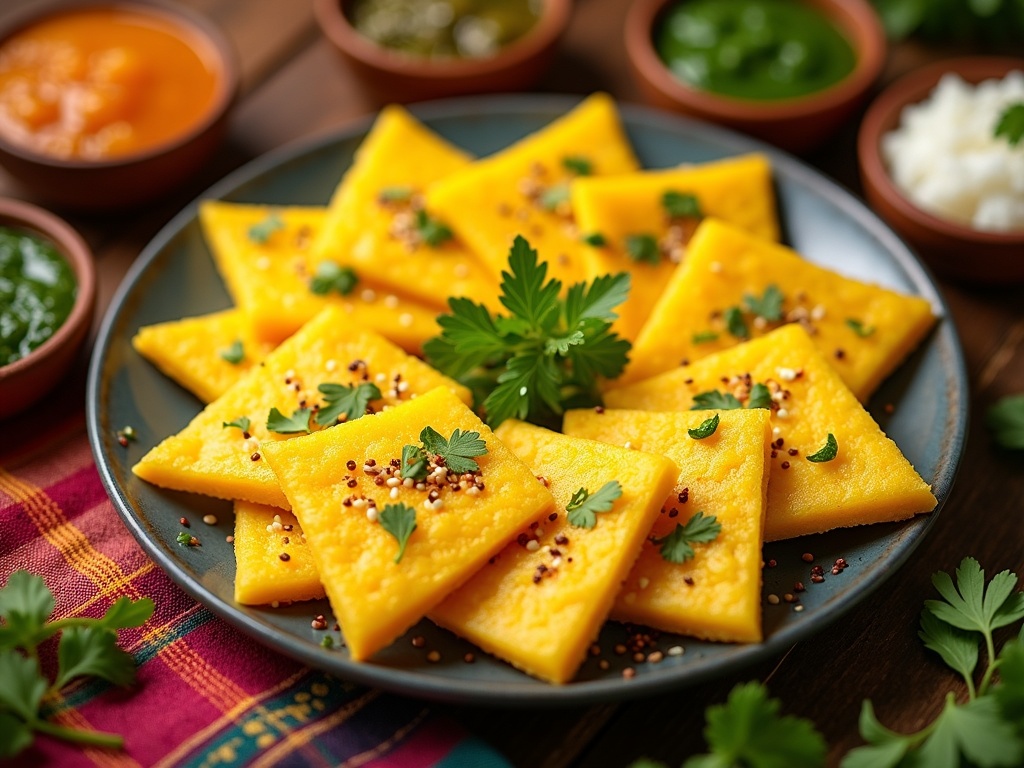Dhokla, a fluffy steamed savory cake from Gujarat, has grown from a local favorite to an internationally acclaimed dish loved for its light texture and tangy flavor. This fermented chickpea flour treat balances health and taste perfectly, serving as a protein-rich, low-calorie option instead of heavier fried snacks.
Find In This Article
Key Takeaways
- Dhokla is a nutritionally dense snack containing approximately 8g of protein and only 150 calories per 100g serving, making it ideal for health-conscious diets.
- The fermentation process enhances both flavor and nutritional value by increasing B vitamins and iron content while improving digestibility.
- Modern variations like khaman dhokla, oats dhokla, and rawa dhokla have helped introduce this traditional dish to global audiences.
- The distinctive tempering (tadka) of mustard seeds, curry leaves, and green chilies creates the signature flavor profile that defines authentic dhokla.
- Dhokla’s versatility allows it to transition seamlessly between breakfast, snack, or light meal, contributing to its growing international popularity.
A Beloved Gujarati Delicacy That’s Taking Over the World
Dhokla stands as one of Gujarat’s most iconic contributions to Indian cuisine, a steamed savory cake that’s light, fluffy, and bursting with tangy flavors. This traditional vegetarian snack has humble origins in western India but has gradually won hearts across the globe. I’ve watched with fascination as this simple dish has made its way from Gujarati households to international food scenes, becoming a symbol of India’s diverse culinary heritage.
The magic of dhokla lies in its distinctive preparation method. Made primarily from fermented chickpea flour (besan), this spongy delicacy gets its characteristic texture through steaming rather than frying. The fermentation process gives dhokla its signature tangy taste while also making it easier to digest. Unlike heavier fried snacks, dhokla offers a guilt-free eating experience that doesn’t compromise on flavor, similar to how vegetable curry balances nutrition with taste.
Cultural Significance and Serving Traditions
In Gujarati culture, dhokla occupies a special place beyond just being a tasty snack. It appears at virtually every significant occasion – from casual family gatherings to elaborate wedding feasts. What makes dhokla particularly versatile is its ability to transition seamlessly between meal categories. Many Gujarati families enjoy it as a nutritious breakfast option, while others serve it as an evening snack alongside a cup of hot chai.
The serving traditions around dhokla enhance its appeal even further. This delightful snack is rarely eaten plain but comes adorned with a variety of accompaniments that elevate its flavor profile:
- Vibrant green chutney made from coriander and mint that adds freshness
- Tangy and sweet tamarind chutney that balances the savory notes
- Spicy garlic chutney for those who prefer an extra kick
- Traditional Indian pickles that complement the mild flavor of dhokla
- A garnish of fresh coriander leaves, mustard seeds, and grated coconut
The tempering (tadka) that tops dhokla is perhaps its most distinctive feature. Hot oil infused with mustard seeds, curry leaves, and green chilies is poured over the steamed cake, creating a sizzling symphony of aromas. This process, similar to the finishing touches in paneer masala, adds depth and complexity to the dish.
What’s particularly fascinating about dhokla’s rising global popularity is how it aligns with contemporary food trends. In a world increasingly conscious about health and sustainability, this steamed snack offers a protein-rich alternative to fried foods. Its plant-based ingredients make it appealing to vegetarians and vegans alike, while its complex carbohydrates provide sustained energy throughout the day.
Dhokla’s ability to stay fresh for several days without refrigeration (though it rarely lasts that long!) made it a practical food choice in pre-refrigeration India. Today, that same quality makes it perfect for meal prep enthusiasts. Its portability also makes it an ideal option for picnics and lunchboxes, much like how samosas travel well but with fewer calories.
The international food scene has gradually embraced dhokla, with variations appearing on menus from London to New York. Creative chefs have begun experimenting with fusion versions, incorporating non-traditional toppings and serving styles. Yet despite this global journey, the essence of dhokla remains unchanged – a testament to how some culinary traditions can cross borders while maintaining their authentic character.
Creating the Perfect Dhokla at Home
I’ve mastered the art of making fluffy, spongy dhokla at home after many attempts, and I’m excited to share my foolproof method with you. This Gujarati delicacy isn’t just delicious but also quite simple to prepare once you understand the key techniques.
Preparing the Perfect Dhokla Batter
The foundation of great dhokla starts with the right batter consistency. I begin by combining 200g of chickpea flour with 100g of fresh curd in a large mixing bowl. Then I gradually add about 250ml of water while whisking continuously to avoid any lumps. The batter should have a medium consistency – not too thick or runny.
Fermentation is crucial for that signature tangy flavor and fluffy texture. I cover the batter with a cloth and let it ferment for 8-10 hours or overnight in a warm place. This fermentation process develops the complex flavors that make Indian snacks truly special.
Just before steaming, I add 1 teaspoon of Eno fruit salt to the batter and gently fold it in. This creates the reaction needed for the dhokla to rise properly. You’ll notice the batter becoming frothy almost immediately – this is exactly what you want!
Steaming and Garnishing Techniques
For steaming, I’ve found multiple effective approaches. My preferred method is using a pressure cooker without the whistle, which creates the perfect steaming environment. I pour the batter into a greased dish, making sure it’s not filled more than halfway to allow room for rising.
The steaming process takes about 20-25 minutes on medium heat. I can tell it’s done when a toothpick inserted comes out clean and the dhokla has a spongy, slightly bouncy texture. Letting it cool for 5 minutes makes it easier to cut into diamonds or squares.
The tempering and garnish truly elevate a simple dhokla to restaurant quality. I heat a tablespoon of oil, add mustard seeds until they splutter, then pour this over the dhokla. Sprinkling sesame seeds and fresh coriander adds both visual appeal and flavor complexity that pairs beautifully with homemade coconut chutney.
If you don’t have a pressure cooker, a steaming basket works just as well. The key is maintaining steady steam without water touching the batter. I sometimes add a teaspoon of turmeric to the batter for that classic yellow color, though this is optional.
For beginners, I recommend these additional tips:
- Always use room temperature ingredients for the batter
- Don’t skip the fermentation step, even if using instant dhokla mixes
- Let the Eno react for exactly 1 minute before steaming
- Don’t open the steamer lid during the first 15 minutes
- Cut the dhokla only after it has cooled slightly
The versatility of dhokla makes it perfect for breakfast, snacks, or even light dinners. I love serving it alongside traditional khichdi for a complete Gujarati meal that’s both satisfying and balanced.
With practice, you’ll develop an intuitive feel for the batter consistency and steaming time that works best with your equipment. Soon you’ll be creating dhokla that rivals any you’d find in the finest Indian cuisine restaurants.

Why This Protein-Rich Snack is Good for You
Dhokla stands out as an exceptional snack option that packs a nutritional punch without weighing you down. I find it remarkable that a 100g serving contains only 150 calories, making it a perfect addition to any health-conscious diet. The nutritional profile extends far beyond just being low in calories.
Impressive Nutritional Profile
The protein content in dhokla is particularly noteworthy – 8g per serving makes it an excellent choice for meeting daily protein requirements, especially for vegetarians looking for plant-based protein options beyond the usual suspects. Each serving also provides 30g of carbohydrates for energy, 6g of dietary fiber for digestion, and only 2g of fat.
Dhokla’s low glycemic index is a significant advantage for anyone monitoring blood sugar levels. This makes it a suitable snack for diabetics who need to carefully choose foods that won’t cause blood sugar spikes. The steady release of energy from dhokla helps maintain consistent blood glucose levels throughout the day.
The fermentation process used to make dhokla isn’t just for flavor – it actually enhances the nutritional value by increasing B vitamins and iron content. This traditional preparation method breaks down anti-nutrients and makes minerals more bioavailable, something I’ve found many modern foods lack.
Health Benefits Beyond Nutrition
Weight management becomes easier with dhokla as part of your diet. The high fiber content (6g per serving) creates a feeling of fullness that lasts, helping to reduce overall calorie intake. I’ve noticed that including fiber-rich foods like dhokla in meals naturally leads to eating less without feeling deprived.
The digestive benefits of dhokla are amplified by the various spices used in its preparation. These spices do more than add flavor – they provide antioxidants that support gut health. The chutneys served alongside dhokla often contain ingredients like curry leaves, mustard seeds, and coconut, which further enhance its digestive properties.
For those looking to boost immunity, dhokla offers several advantages. The fermentation process creates beneficial bacteria similar to those found in yogurt, supporting a healthy gut microbiome. Since approximately 70% of our immune system is located in the gut, foods that promote gut health naturally support immune function.
Dhokla’s versatility also makes it an ideal choice for various dietary needs. It can be customized with different flours and spice combinations to suit specific health requirements. For instance, adding vegetables to the batter increases the vitamin and mineral content, while reducing the salt can make it suitable for those monitoring sodium intake.
As a between-meal snack, dhokla provides sustained energy without the crash that comes from processed foods. The combination of complex carbohydrates and protein helps maintain energy levels, making it perfect for busy days when you need something substantial but light. I particularly appreciate having dhokla as a mid-morning snack when I need something to tide me over until lunch without feeling heavy.
For those monitoring their fat intake, dhokla offers satisfaction without excess oils. Unlike many fried snacks that can contain 15-20g of fat per serving, dhokla delivers flavor and substance with just 2g of fat, proving that tasty snacks don’t have to be unhealthy. Pairing it with other balanced foods creates a well-rounded meal that satisfies both nutritional needs and taste buds.

Modern Twists on a Traditional Favorite
Dhokla has gone through an incredible evolution over the years, shifting from a purely traditional Gujarati dish to one that’s been reimagined countless times. I’ve discovered that while the classic recipe remains beloved, these modern variations have made this healthy steamed snack accessible to even more food enthusiasts.
Popular Dhokla Variations
Khaman Dhokla stands as perhaps the most popular contemporary version. Unlike traditional dhokla, khaman uses chickpea flour exclusively, creating a softer, more spongy texture. I’ve found its vibrant yellow color and tangy sauce make it particularly appealing for gatherings. The tempering with mustard seeds, curry leaves, and green chilies adds that perfect finishing touch to this lighter adaptation.
Oats Dhokla has gained tremendous popularity among health-conscious food lovers. By replacing some or all of the traditional gram flour with oats, this variation boosts the fiber content significantly. I add vegetables like grated carrots or bottle gourd to enhance both nutrition and flavor. This makes for an excellent nutritious breakfast option that pairs wonderfully with mint chutney.
Rawa Dhokla offers a completely different texture experience. Made primarily with semolina (suji), this version has a slightly grainy texture that many find appealing. The semolina base makes it quicker to prepare since it doesn’t require fermentation. I often pair it with coconut chutney for a delightful contrast of flavors.
Innovative Takes and Global Adaptations
Contemporary versions of dhokla have embraced exciting additions that enhance both nutrition and presentation:
- Spinach Dhokla incorporates pureed spinach into the batter, creating a beautiful green color while boosting iron content.
- Peas Dhokla features whole or crushed green peas, adding texture and a sweet pop of flavor.
- Paneer Dhokla includes grated paneer for a protein boost, making it similar to other paneer-based dishes but with a healthier preparation method.
- Tricolor Dhokla layers different colored batters to create a visually stunning dish, perfect for special occasions.
International adaptations have taken this humble dish to new heights. In the United States, I’ve seen fusion versions featuring ingredients like corn, bell peppers, and even cheese. Some cafes serve “dhokla sandwiches” where thin slices are used instead of bread. In Southeast Asia, dhokla recipes often incorporate local herbs and spices like lemongrass or galangal.
The British adaptation sometimes includes ingredients like zucchini or broccoli, while maintaining the steamed preparation technique. Some innovative chefs have even created dhokla canapés for cocktail parties, topped with avocado or hummus.
What makes these adaptations so appealing is that they maintain the core essence of dhokla—steamed, fermented, and healthy—while introducing new flavors. These creative versions have helped dhokla transcend cultural boundaries. For those who enjoy cooking projects, experimenting with combining dhokla with khichdi creates an interesting textural contrast in a single meal.
The beauty of modern dhokla variations lies in their versatility. They can serve as breakfast, snack, or even a light dinner option. The quick-cook versions like instant khaman often accompany samosas at parties, creating a balance of fried and steamed options.
I’ve found that these contemporary takes have helped introduce dhokla to those who might otherwise be intimidated by traditional Indian cuisine. By incorporating familiar ingredients while maintaining the dish’s healthy steamed preparation, modern dhokla has secured its place as both a comfort food and a trendy option for health-conscious diners.
From Gujarat to Global Tables
Dhokla holds a special place in my heart as an integral part of authentic Gujarati thalis. This steamed savory cake made from fermented batter offers a perfect balance of tanginess and sponginess that makes it impossible to stop at just one piece. When I visit a traditional Gujarati household, dhokla is almost always present on the thali, nestled among other regional specialties like khichdi and its accompaniments.
Cultural Significance and Global Reach
During Navratri celebrations, dhokla takes center stage as a fasting-friendly food that’s both nourishing and delicious. Its protein-rich composition makes it an ideal snack during the nine days of festivities when many Gujaratis abstain from grains. I’ve noticed how families prepare special variations of dhokla during this time, often garnished with coconut chutney and vibrant green chutneys.
As a symbol of Gujarat’s culinary heritage, dhokla tells the story of resourcefulness and innovation. The technique of fermenting and steaming batter creates a cake-like texture without an oven – a testament to traditional cooking methods that predate modern kitchen appliances. Similar to how samosas have become globally recognized, dhokla too has begun its international journey.
In recent years, I’ve spotted dhokla on menus of Indian restaurants in London, New York, and Sydney. Innovative chefs are giving this humble dish upscale presentations, sometimes pairing it with paneer dishes or incorporating fusion elements. One restaurant in Toronto serves miniature dhokla topped with avocado chutney, representing an interesting culinary crossover.
The globalization of Indian cuisine has carried dhokla far beyond its Gujarati origins. International food enthusiasts appreciate its lightness compared to heavier Indian dishes like butter chicken. Food bloggers and social media have played a significant role in popularizing dhokla, with many non-Indians trying their hand at making this steamed delight at home.
What makes dhokla particularly appealing in global food circles is its versatility. It fits perfectly into contemporary food trends – it’s naturally vegetarian, easily made gluten-free, and works wonderfully alongside vegetable curries for a complete meal. Its fermentation process also appeals to those interested in probiotic-rich foods.
From humble beginnings in Gujarati kitchens to sophisticated presentations in international restaurants, dhokla’s journey reflects the growing global appreciation for regional Indian cuisines beyond the standard curry house fare.
Essential Ingredients and Flavoring
Dhokla, one of India’s most beloved snacks, relies on a specific set of ingredients that create its signature soft, spongy texture and tangy flavor profile. I’ve found that understanding these core components is crucial for anyone attempting to recreate this classic Gujarati dish at home.
The Building Blocks of Perfect Dhokla
The foundation of any authentic dhokla begins with chickpea flour (besan), which gives the dish its distinctive yellow color and nutty flavor. This protein-rich flour is mixed with water to form a batter, but the magic happens when curd is added, creating that signature tangy taste. The fermentation process is accelerated with Eno fruit salt, a key ingredient that gives dhokla its light, fluffy texture by creating tiny air bubbles throughout the batter.
The flavor profile comes alive with these essential spices and aromatics:
- Turmeric powder for that golden hue and subtle earthy notes
- Finely chopped green chilies that add heat without overwhelming
- Freshly grated ginger for a warm, aromatic punch
The tempering (tadka) elevates dhokla from good to exceptional with:
- Mustard seeds that pop and release their nutty flavor when heated in oil
- Sesame seeds that add a delicate crunch and nutty dimension
- Curry leaves for their unique citrusy aroma (optional but recommended)
I always finish my dhokla with a generous sprinkle of fresh coriander leaves, which adds a burst of color and freshness that balances the savory elements perfectly. The herb’s bright, citrusy notes complement the subtle tanginess of the dhokla.
No dhokla experience is complete without proper accompaniments. Freshly prepared coconut chutney with hints of green chili and ginger makes an ideal pairing. For those who enjoy something sweeter, date and tamarind chutney offers a perfect contrast to the savory dhokla. A side of spiced vegetable curry can transform your dhokla from a snack into a satisfying meal.
While traditional dhokla recipes remain popular, many home cooks now experiment with creative variations. Some add grated paneer for extra richness, while others incorporate finely chopped vegetables for added nutrition and texture. The versatility of dhokla makes it an excellent canvas for culinary creativity.
The quality of ingredients significantly impacts the final outcome. I recommend using fresh chickpea flour that hasn’t been sitting in your pantry for months. Similarly, fresh ginger and green chilies make a noticeable difference in flavor compared to pre-packaged alternatives. When making dhokla for special occasions, I’ve found that fermenting the batter naturally (without Eno) for 6-8 hours creates an even more complex flavor profile, though it requires more planning ahead.
For beginners, I suggest starting with the basic recipe before experimenting with variations. The standard proportions—one cup of chickpea flour to about half a cup of curd and water, with a teaspoon of Eno fruit salt—offer a foolproof foundation. As you gain confidence, you can adjust these ratios to achieve your preferred texture and taste.
When served hot with its traditional garnishes and accompaniments, dhokla offers a beautiful balance of flavors and textures that explains its enduring popularity across India and beyond. Its nutritional profile—high in protein and low in fat—makes it a smart choice for health-conscious food lovers looking for satisfying snacks that don’t compromise on flavor.

Sources:
The Complete Book of Dhokla Recipes
Healthy Indian Cooking: A Guide to Nutritional Benefits by Meena Sharma
Exploring Gujarati Cuisine by Aditi Mehta

